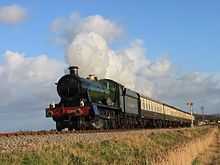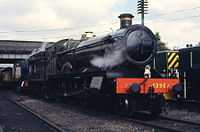Preserved GWR Modified Hall Class locomotives
This is a list of GWR 6959 (Modified Hall) Class locomotives that survive in preservation.
6960 Raveningham Hall

The locomotive was built in March 1944 at Swindon Works. Its first shed allocation was Old Oak Common. The locomotive was withdrawn from service in June 1964 and sold to Woodham Brothers scrapyard in Barry, South Wales for cutting up. However it was saved for preservation and left the yard in October 1972 by mr David Edleston of derby. It was eventually sold to Steamtown Carnforth as the 26th departure from Barry. Restored in 1975, she was then based at the Severn Valley Railway where she ran with 4930 Hagley Hall's tender while her own was put behind 4930. She left the Severn Valley Railway in 1996. Sold to Jeremy Hosking, by 2008 it was at The Flour Mill workshops in the Forest of Dean receiving a thorough overhaul. Proposed to run at the Gloucestershire Warwickshire Railway, restored from 2009 to operational condition in November 2011 at the West Somerset Railway.
6984 Owsden Hall
This locomotive was built in February 1948 at Swindon Works. Its first shed allocation was Hereford. It was withdrawn from service in 1966 and sold for scrap to Woodham Brothers scrapyard. In 1986 it was saved for preservation and moved to the Gloucestershire Warwickshire Railway and remained there until 2013 when it moved to the Swindon and Cricklade Railway where its restoration will be completed.
6989 Wightwick Hall
6989 was completed on 25 March 1948 at Swindon Works, and was first based at Hereford. The locomotive was withdrawn in June 1964, and sold to Woodham Brothers scrapyard on 17 July 1964. In 1978, the locomotive was purchased by the Quainton Railway Society. It was the 88th engine to leave Barry to go into preservation, and is currently under restoration at the Buckinghamshire Railway Centre.
6990 Witherslack Hall

6990 was built at Swindon in 1948 and withdrawn in January 1966. It was bought by the Witherslack Hall Locomotive Society and it arrived on the Great Central Railway in November 1975, having operated on the line during its BR days. Restoration was completed in 1986. It last worked in 2001 and is now undergoing another overhaul for use again on the GCR.
6998 Burton Agnes Hall

The locomotive was built by British Railways to GWR specifications at Swindon in January 1949, and named after the Yorkshire stately home. Initially based at Cardiff, it was finally withdrawn by British Rail in 1966. The locomotive was acquired by the Great Western Society in the same year, and moved to the Didcot Railway Centre in 1967. Since 1996 the locomotive has been a stationary exhibit.
7903 Foremarke Hall
The locomotive, like 6998, was built in 1949 at Swindon Works. First shed allocation was Old Oak Common, and it was named after the Derbyshire stately home. The locomotive was withdrawn from service in 1964 and sold to Woodhams' Scrapyard. Nearly twenty years later, in 1981, it was moved to the Swindon and Cricklade Railway where restoration work began. Restoration was completed 22 years later in 2003, and the locomotive was used on the S&CR before moving to the nearby Gloucestershire Warwickshire Railway, and apart from a visit to the Severn Valley Railway in September 2005, has remained based at the GWR ever since. It appears in the 2013 Series 1 of the BBC drama Father Brown, episode 1: The Hammer of God. It is currently being overhauled with the boiler and frames at Tyesley works, and the tender and smaller parts remaining at Toddington.
7927 Willington Hall
Frames of locomotive purchased as part of a project to re-create a GWR 1000 "County" Class locomotive, No.1014 "County of Glamorgan". The boiler is going to be used for new-build Grange Class No. 6880 Betton Grange.
External links
| Wikimedia Commons has media related to Preserved GWR 6959 Class locomotives. |